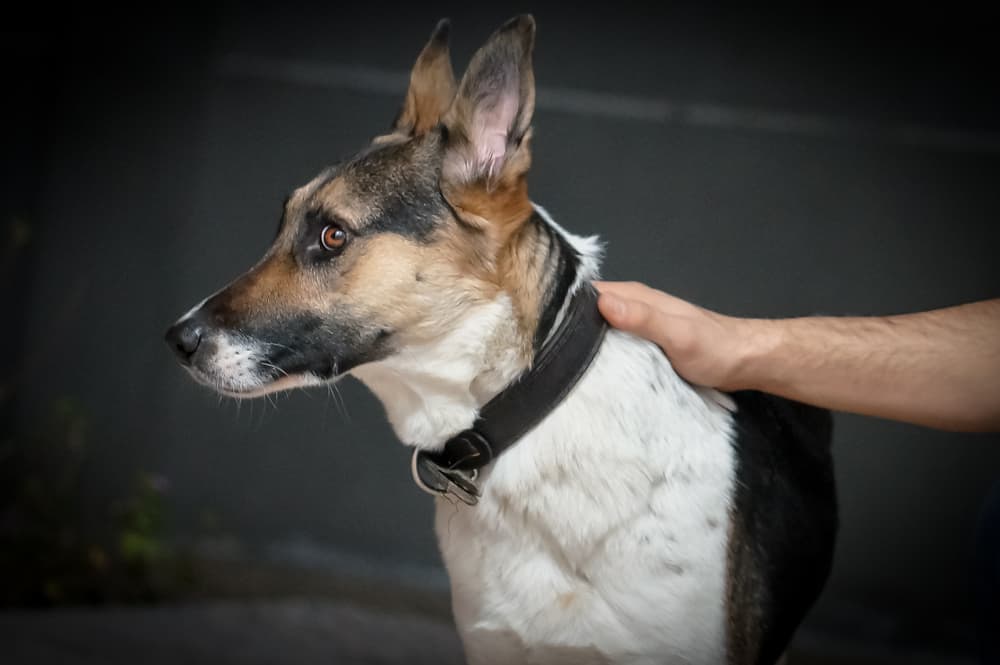Facts You Should Know About Panda German Shepherds
Panda German Shepherd is not commonly heard of. If you’ve never heard of a Panda German Shepherd or glimpsed one, you’re not alone!
A Panda German Shepherd is a purebred German Shepherd and makes for some handsome canines. It has black and white symmetrical markings, especially around its eyes, similar to a panda.
Like their standard-colored counterparts, Panda German Shepherds were conceived from Germany, where they worked to herd sheep until the late 19th century.
The Panda German Shepherd is a unique breed of a GSD, and the Panda German Shepherd is also called the Piebald German Shepherd.

The first known Panda GSD was born in 2000 to a purebred German Shepherd Dogs with a long line of purebred heritage.
So, how do they compare to a regular German Shepherd?
Panda German Shepherds are similar to all other German Shepherd Dogs, and the only striking difference between them is that they have unique coloring and coats.
They are just as healthy and hold the same health record in their lineage as German Shepherds. The overall health depends on the breeder in which the Panda was raised, as it is for purebred dogs.
Let’s discuss the health and maintenance of Panda German Shepherd.
A reliable breeder is someone who genuinely cares about the health of their dogs and will not breed dogs that are predisposed to health issues.
Nevertheless, there are specific health issues that German Shepherds can have due to their build. Hip dysplasia can be bred out of a line during breeding, but it can skip generations as it is so prominent.
Bloat is a common health issue among German Shepherds that cannot be ruled out, and this happens due to the breed’s size and is found among other large and giant breed dogs with deep chests.
Pandas are not recognized by the American Kennel Club (AKC) as their official standard of the GSD states that they are different from GSD in color, and blues or livers are serious faults, so a white dog must be disqualified.
Panda GSD is considered purebred as it consists of a mutation of the KIT gene, which leads to its unusual markings.
You need to know some essential things before you decide to get a Panda German Shepherd.
Find a breeder who will carry out health testing on all of their breed stock as they will focus on their dogs’ common health issues and temperament.
According to the German Shepherd Dog Club of America, principled breeders breed temperament, confirmation, and trainability.
These are the significant attributes of the GSD, whether Panda or Black and Tan in the coat.
As far as the cost is concerned, a Panda German Shepherd is expensive compared to a black and tan German Shepherd. Undoubtedly, this steep purchase price is due to supply and demand.
As the Panda GSD is rare, they are often spoken for when they are born before their eyes even open.
Overall, a Panda German Shepherd is an attractive dog. While Panda German Shepherds look different with their coat color, they still share similar characteristics and traits with your average German Shepherd.
Nonetheless, they can be a little more discreet on the whole.
Panda German Shepherds are unique in that they’re typically black and tan, with roughly 35% white.
However, a German Shepherd can show Panda patterning on any coat that isn’t white.
Other than color, Panda Shepherds are the same as other GSDs, sharing identical conformation, intelligence, temperament, and working qualities.
Where Did Panda German Shepherds Originate?
Panda Shepherds, like every other Shepherd, can trace their lineage to Beowulf.
Beowulf, like his grandsire, Horand von Grafrath, fathered almost 100 pups, many through inbreeding.
Horand, of course, was the foundational sire of the German Shepherd breed, hand-selected by Max von Stephanitz in 1899 in Germany.
Cindy Whitaker unintentionally bred the first-recorded Panda German Shepherd in 2000 in the United States.
The father was Brain vom Wölper Löwen SCHH III, a black and tan dog who had a German Shepherd Club of Germany registration.
Cynthia Madchen Alspach, a solid black Shepherd, was the pup’s mother and was a part of the AKC registry.
The American Kennel Club proved through DNA tests that the Panda German Shepherd puppy, named Lewcinka’s Franka von Phenom or Franka, was a purebred German Shepherd.
Her owners subsequently registered her with the AKC, and she passed OFA scoring on her elbows and hips.
Franka was the only Panda offspring of her parents despite three more breedings. However, many of Franka’s puppies expressed panda patterning.
Later research revealed that the panda pattern, although similar to the piebald expression in other breeds, was a relatively recent spontaneous mutation.
How Do Panda German Shepherds Differ From Piebald Dogs Of Other Breeds?
Scientists’ understanding of the role of genes in coat colors in dogs is still evolving, especially regarding the appearance of white.
Piebald in many breeds is an expression at the S locus
Coat color pattern is tricky in dogs because not only is it the result of genetics, but it also receives specific coding from the breed.
Piebald is the expression of white spotting or markings. Many dog breeds carry the piebald gene on the S locus or location.
S alleles can be incompletely dominant or recessive. If recessive, dogs must have both copies of the piebald gene at S to have any white markings.
Alternatively, incomplete dominance means one copy of the piebald gene may show some white markings while two copies would produce more dramatic areas of white or even solid white.
One example of an animal that exhibits incomplete dominance of the piebald gene and great variations in its expression is the Bulldog.
Several breeds like the Great Dane, Irish Setter, and Boston Terrier exhibit symmetrical Irish white type markings while others, such as the Dachshund, are more random.
To confuse the issue further, Irish white is a specific pattern you see in Collies and other breeds mentioned above.
An Irish white pattern is among the most symmetrical coat color variations and involves a recessive gene on the S locus that is distinct from the piebald gene.

(photo: d_mann117)
Panda gene in the GSD is a KIT mutation
It was not until 2016 that UC Davis discovered a mutation in the KIT gene was responsible for the panda pattern in German Shepherds.
Although originally springing up spontaneously from standard parents, the GSD panda coat pattern is a dominant gene.
Any dog with the gene for panda coloration will display the symmetrical white pattern and will pass the gene to 50% of their puppies.
Panda is a type of piebald pattern.
White usually shows up minimally on the tip of the tail, as a white blaze down the face, a white ring around the muzzle, a splash across the chest and belly, and a collar around the neck of Panda German Shepherd puppy.
Individuals may exhibit more or less white, but the pattern remains similar between dogs.
Another unique feature of the Panda gene is that two copies are lethal, killing the embryo before full development. It shares embryonic lethality in common with the merle gene.
Many Panda Shepherds have a base color of black and tan, but the pattern can also show up in solid blue, black, or liver dogs as well as liver and tans, silver and tans, and blue and tans.
What does the KIT gene do?
The KIT gene, also known by other names such as Receptor Tyrosine Kinase and the Piebald Trait Protein, contains a blueprint for producing proteins that transmit important information from the cell surface to the inner working parts.
Thus, KIT enables processes such as cellular growth and migration of cells to their specific areas of function.
For example, KIT genes ensure cells that are responsible for nerve function in the gut arrive in the small intestine.
Likewise, KIT genes direct pigmentation cells called melanocytes to migrate throughout areas of the coat, most pertinent in the Panda German Shepherd.
Where the melanocytes fail to arrive is where you see white spotting.
One area you may not often think about concerning melanocytes is as pertains to the eye. Panda Shepherds may have blue eyes if KIT mutation affects melanocyte migration to the iris.

We Promise The Panda German Shepherd
Is A True German Shepherd!
The Panda Shepherd has faced resistance for much of its existence. Franka’s owners had their doubts when they had her DNA tested.
The American Kennel Club received early proof of the Panda German Shepherd’s purebred heritage but classified the pattern as well outside of the breed standard.
Many German Shepherd registries along with the AKC disqualify dogs with any white coloration from conformational show rings.
However, they don’t exclude dogs from their registries based on color. Germany prevents the registration of white German Shepherds.
Some breeders even maintain long-held beliefs that Panda Shepherds have and pass along the white gene and, worse, cause fading in dogs who are standard colors.
Genetic laboratories have confirmed that Panda Shepherds don’t possess a white gene but are unsure about the effect on color intensity.
Despite the efforts by some breeders and fanciers to promote the Panda Shepherd as a separate breed, it’s still a German Shepherd.
They share all of the same characteristics as the German Shepherd except color and don’t suffer additional health problems.
Health concerns
- Large head with stop and slight dome shape to forehead; large upright ears
- Slightly sloping topline from withers to hips, longer in length than height
- Strong muscular frame and legs
- Bold, confident, driven, focused, and intelligent
- Easy to train for the experienced handler, obedient – will bully or try to dominate less confident owners
- Medium-large dogs – 22 to 26 inches tall, 50 to 90 pounds
- Excel on multiple levels – police, military, agility, therapy, guide, tracking, Schutzhund, guarding, herding
- Health issues – degenerative myelopathy, hip dysplasia, elbow dysplasia, Pannus which affects the cornea of the eye, skin allergies, clotting disorders like von Willebrand’s, bloat, low thyroid, pancreas disorders
- Dense short to medium-long double coat that continuously sheds with seasonal heavy shedding
- Good with children with early socialization and supervision
- High-energy working dogs that require up to two hours or more of daily exercise and up to three years of conscientious socialization; need ongoing training and mental stimulation
- May be dog aggressive, may not be suitable around smaller animals
- Wary of strangers – can waver between extremes of shyness or timidity and dangerous aggression if not properly socialized or if abused

(photo: novathepandashepherd)
Like White Shepherd enthusiasts, many Panda owners seek to create a separate identity for their dogs so they can participate in sanctioned conformation shows.
Others seek to capitalize on the rarity of the Panda Shepherd and, as a result, often breed irresponsibly and charge exorbitant prices.
Unfortunately, most so-called Panda Shepherds are likely mixed dogs as people once feared in the first place.
There are a few characteristics that may alert you that a Panda Shepherd has mixed heritage and a seller may be trying to manipulate you.
Exercise caution when adopting a Panda German Shepherd
- Tail – curled over back, too short, or rope-like rather than a brush
- Shortened muzzle or face too narrow with a pointed snout – Heeler or Collie respectively
- Colors not seen in the German Shepherd – merle; Panda Shepherds can have black spots on the muzzle
- White that extends past the shoulders onto the body other than the ventral abdomen sometimes extending slightly upwards – a splash of white on the trunk is not a pattern we see in the Panda Shepherd
- Non stereotypical distribution of solid colors not usually seen in the GSD such as patchwork black and tan on two sides of the face – Cattle Dog and Aussie color pattern
- The body shape that is not German Shepherd-like
If you want a Panda Shepherd Dog, perform due diligence as you would for any pet.
You should ideally visit the breeding location and be able to see any parents onsite. Breeders should be able to provide you certification on hips and elbows, and pedigree lineage for the parents.
You must DNA test a Panda Shepherd before you can register it with the AKC. Anyone proclaiming to sell a Panda Shepherd should have DNA proof available.
If they have Panda German Shepherd pups, one of the parents has to be a Panda. You can also register the Panda Shepherd with the Dog Registry of America, Inc.

(photo: zoethepandagsd)
Examples
A Panda German Shepherd should leave no doubt about their breed. Other than the color you would not know the difference between this dog and any other GSD.
Note the signature large upright ears of the GSD in this video, a long bushy tail, slightly sloping topline with a frame somewhat longer than the dog is tall.
Moreover, Dakota is attentive to her handler but devoted to her owner. Another feature of the piebald coloration is that it is roughly symmetrical.
This dog is a black and tan panda color.
This is another example of how a Panda Shepherd should look exactly like a German Shepherd.
This working dog illustrates Irish white spotting in a Shetland Sheepdog.
Not only is the white in a stereotypical pattern on paws, face, chest, neck, and tail tip, but it breeds true, indicating affected dogs have two copies of the gene.
Shelties are unique as a breed in that individuals can exhibit either a piebald or an Irish spotting gene, according to Champagnekennels.com.
Most breeds have one or the other exclusively. A few other breeds that demonstrate Irish white spotting are Scotch Collies, Boston Terriers, and Bernese Mountain Dogs.
Note the similarities between the Panda pattern and Irish white spotting, which involves a completely different gene.

(photo: novathepandashepherd)
Frequently Asked Questions
Are panda German shepherds rare?
Yes, Panda German Shepherds are rare. When it comes to the rarest dogs that are available, Panda German Shepherds are one of the rarest.
They are so rare that often people are unsure of what one is.
While they are rare due to how beautiful they are and their personalities, they are a highly sought after type of German Shepherd dog (GSD).
Their coat is tricolor, and the majority of their coat is white.
When you take into consideration the color of a standard German Shepherd, it is easy to see how this type is striking in its appearance in comparison.
As they are so rare it is difficult to determine whether a GSD is going to be a Panda. However, it is thought that this coloring is linked to the piebald gene.
This is present in this variation of GSD.
How much do panda German shepherds cost?
When taking into consideration the cost of Panda German Shepherds, due to their rarity, they are quite expensive. In comparison to a standard German Shepherd, the cost is significantly higher.
Typically, a Panda German Shepherd dog will cost around $1000 – $3000. This is significantly more expensive than a standard GSD.
The price can fluctuate to be above this cost too.
The price you pay will vary depending on the breeder, the area you live in, and the state too.
When purchasing a Panda German Shepherd, it is so important to ensure that you have chosen a reputable breeder.
You will want to see a copy of the parents’ health certificates and ensure that the animals are being well cared for, as they can potentially have health issues.
Are panda German shepherds purebred?
Yes, Panda German Shepherds are purebred, rather than a designer one. While this may not be assumed due to their markings, they are seen to be purebred.
Their color comes from a mutation in their genes, rather than through a specific breeding process.
The first Panda German Shepherd Dog was accepted by the American Kennel Club as a purebred. As a result of this, this type of GSD was then accepted as a purebred, rather than a designer breed.
While Panda German Shepherds do look different with the color of their coat, they still share similar characteristics and traits with your average German Shepherd. However, they can be a little more cautious on the whole.
When looking at their health, they are still prone to many of the same issues such as hip dysplasia, cancers, and elbow dysplasia.
This is why it is always important to ensure you are purchasing a Panda German Shepherd from a reputable breeder to help prevent hereditary issues from occurring.






























